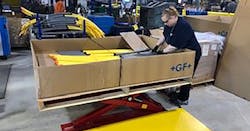Georg Fischer Americas, Piping Division
Georg Fischer Americas, Piping Division
Irvine, CA
Manufacturer and distributor of pipe and fittings for the oil, water and natural gas industries
1,400 employees | 8 sites | 7 EHS professionals
When COVID-19 first struck, most businesses were caught off guard, but Georg Fischer quickly sprang into action.
The company, which manufactures pipes and fittings, had already prepared a pandemic plan and was able to act even before many local governments. The plan includes now-standard practices of social distancing, taking employees’ temperatures, mandatory mask wearing, providing PPE, increased disinfecting and hiring additional cleaning staff. Georg Fischer also took the following proactive measures:
• Each department shuts down 15 minutes early before lunch and end of shift so employees can disinfect their areas.
• No visitors or contractors on-site unless approved by the president of the company.
• At some locations, lunches were brought in for employees to limit employees from leaving the facilities.
The company continues to send COVID-19 updates via corporate email and intranet.
And while COVID-19 is certainly top of mind, it’s just one effort among many Georg Fischer has taken in recent years to improve safety. The company has been working to implement Safety at Work Standards, which are required at all locations, many of which exceed OSHA regulations for safety. Lean manufacturing and Six Sigma are additional tools the company employs to assure a safe workspace.
Georg Fischer conducts hazard and risk assessments as part of its Zero Risk safety campaign. All tasks must be analyzed and all risks eliminated or mitigated by either engineering controls, substitution/elimination, administrative controls or PPE. These hazard and risk assessments are used to help create standard operating procedures for each job or task.
One example of Zero Risk in action is the hand safety initiative the company launched after identifying hand injuries had the highest injury rate. Georg Fischer educated its workforce on hand injury prevention and conducted training. Audits were performed to identify the safest cutting tools, and cut resistant gloves were made mandatory for certain tasks. Each site implemented a cutting tool matrix/guide to help employees identify the safest and most appropriate cutting tool for each cutting application. The combined efforts have resulted in a significant reduction in recordable hand lacerations.
As a proactive measure, engineering conducts risk assessments on all new product development to ensure all hazards are controlled before advancing to the next phase.
“I believe we have shown continual improvement in safety performance the past few years,” says Lewis Chambers, EHS manager. “We have gone from locations working alone to several locations that work together and share information and practices to improve safety.”
About the Author
Nicole Stempak
Nicole Stempak is managing editor of EHS Today and conference content manager of the Safety Leadership Conference.

